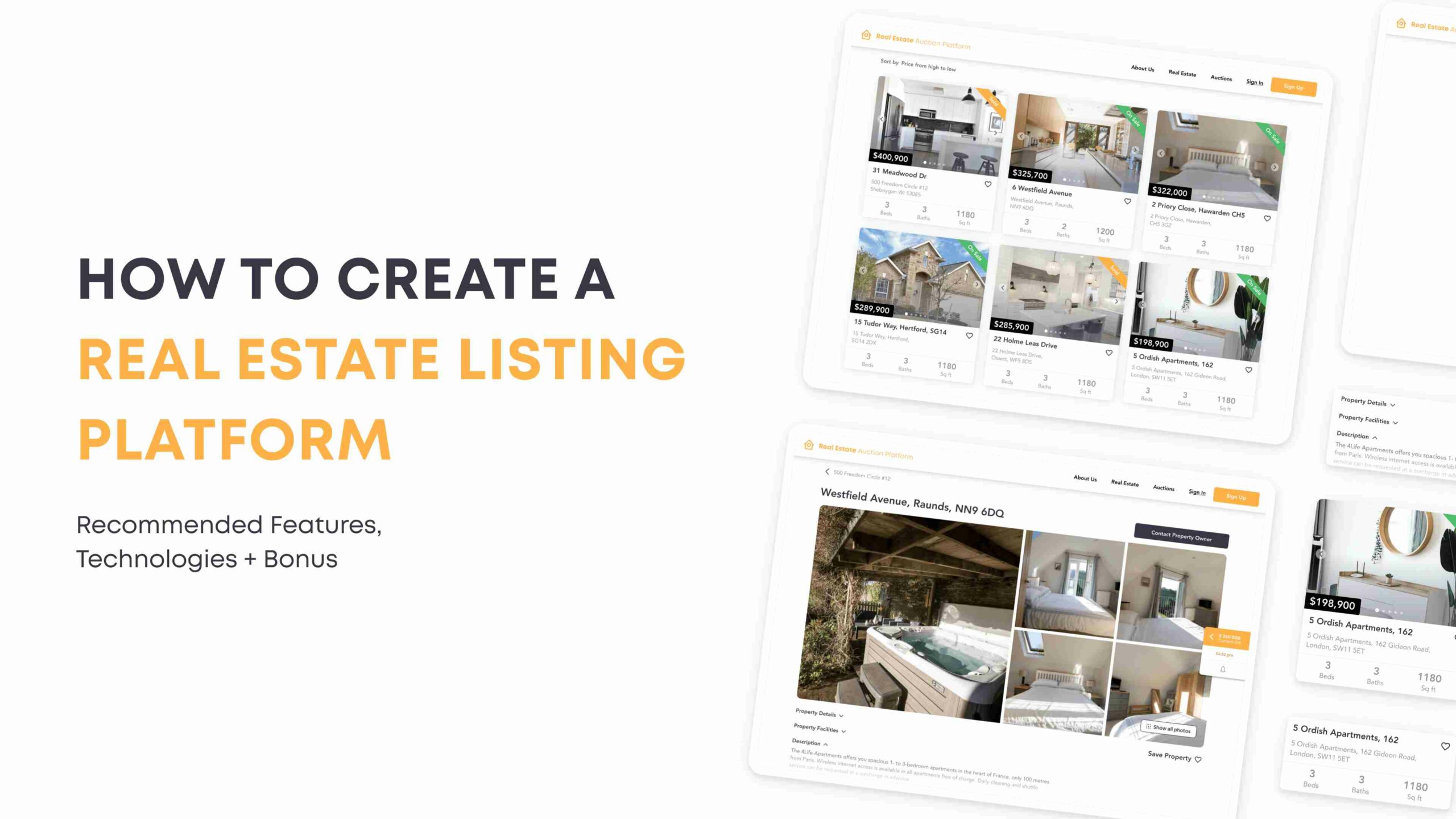Home prices soared, buyer demand raised, and mortgage interest rates hit record lows. One of the reasons for all of this beyond the COVID-19 pandemic is technology acceleration. This factor doesn’t get the headlines but also makes a noticeable difference in the US housing market. Digital closings, remote mortgage approvals, and real estate listing platforms have fast-forwarded the speed at which homes are marketed and sold.
Nowadays, a professional website is the backbone of your business and a top-selling tool in the modern marketplace.
In this tech guide to building a real estate platform, we will tell you how to design a user-centered, intuitive web application and ensure a quality data flow to gain a market leadership position.
Main components: Property listing platform components
Knowing the project structure is essential for streamlining the development process. Here are a few elements that you should be aware of.
- Front-end When you visit any real estate site, you see pages with visual elements, content, and features. But it’s only a part of a website that users can see and interact with, called the front-end. The front-end combines two elements: the graphic design (the look) and the user interface (the feel).
- Back-end (or server-side logic) Everything that happens in the background and is not visible to your users, like search algorithms, third-party integrations, application business logic, is attributed to back-end web development. This invisible part of a website is an enabler for a front-end web experience that consists of a server, an application, and a database.
- Mobile application. When developing a platform, it’s of paramount importance to make it mobile-first. As of April 2021, 54.8% of all web traffic was generated by mobile phones, excluding tablets. Mobile users don’t want to scroll horizontally or zoom to read your content, so ensure your house listing site easily adapts to any screen size.
- Admin dashboard. The administration system is another indispensable component of the e-property websites. Admin panel is the control center that allows you to view reports and analytics, manage properties, system settings, agents, and platform visitors, and perform many other admin-specific functions.
Now, let’s dive into the web development process.
Features: Recommended real estate website features
Almost any property portal includes functionalities and tools that help buyers find a perfect home, and agents promote their business.
Based on our website development experience, we compiled a list of features that we consider are essential for most real estate listing platforms.
Recommended Real Estate Website Features
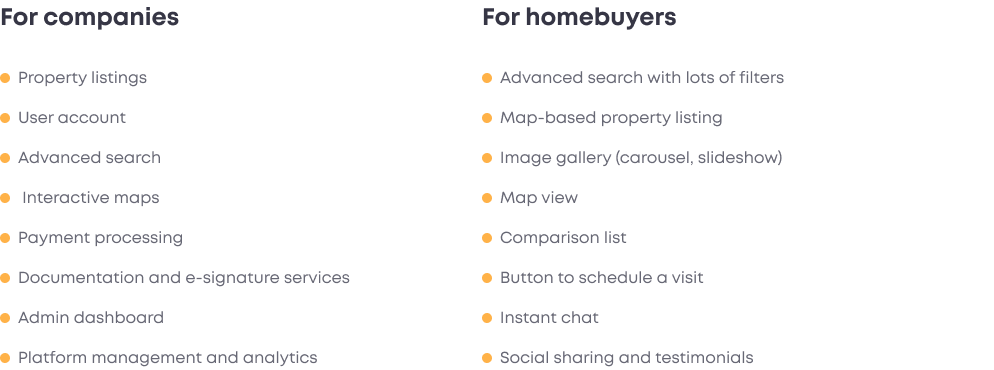
1. Property listings
There are several ways how the properties can appear on your platform:
Database
Databases with properties are a core feature for a home listing site and the primary reason for its existence. If you already have the database, website developers can integrate it into the website’s back-end.
The database will contain a standard set of fields – address, description, amenities, images, number of bedrooms, and others – yet adjusted to your needs.
User contribution
Enabling users to list their homes without the assistance of agents is another way of keeping listings updated while growing your housing portfolio. For instance, 80 million out of 110 million listings on Zillow are contributed by users. Thus, your property listing website will be the primary source of information for potential buyers.
If you want users to post listings, make sure you have all the necessary functionality that allows sellers, homeowners, and agents to upload their listings on your site.
API integrations
Most of the property search services rely on Multiple Listings Service or MLS listing database for their home listings data. However, integrating MLS can be challenging because you must have a real estate license in each U.S. state, which requires both time and money.
Alternatively, you can pull databases from third-party services like Zillow, Trulia, Redfin via API integrations. It’s a cost-effective way to get access to real-time real estate data. For instance, Zillow has its API, and the company allows integrating API to websites but not mobile apps.
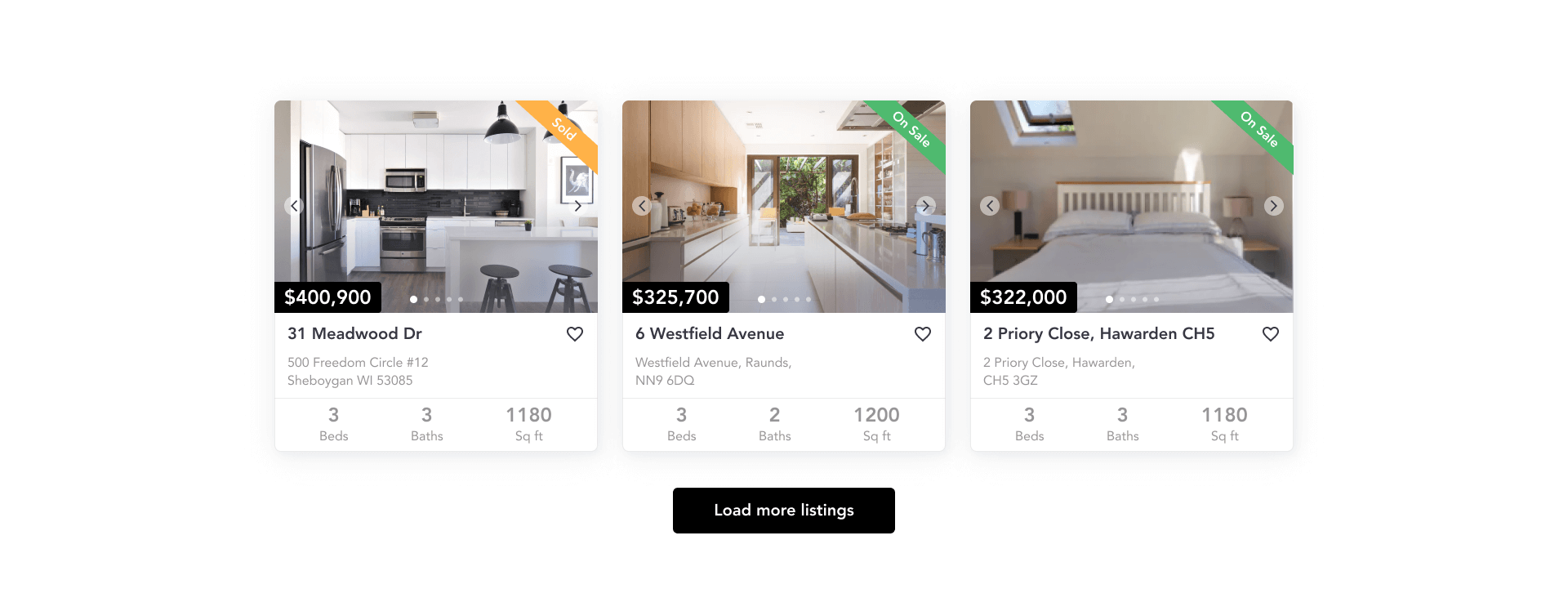
2. User account
While building a new web app, make the registration process short and easy. Modern consumers embrace easy-to-use platforms that require minimal effort to create an account, and we strongly recommend following this trend. Provide your prospects with the ability to sign in with social media accounts, email, or phone numbers to facilitate their efforts and improve the user experience.
Your website might have several different types of users: homebuyers, sellers, and real estate professionals. Each of them will have distinct features and tools. For example, homebuyers look for properties for sale, so it’d be great if you implement advanced features such as saved search results, instant support, or mortgage calculators. Meanwhile, agents need access to lists, schedules, and interested customers. All of this needs to be taken into account when you create a strategy for your platform.
3. Advanced search
The search feature is the heart of an online listing platform. You can add tons of value to the business by adding extra filters and search criteria. The more control your platform’s search engine can offer visitors, the more chances there are for prospective buyers and tenants to find the best deal.

4. Interactive maps
It’s a powerful and flexible tool that allows customers to pinpoint the best property offerings based on multiple criteria. A map is usually tied to the search tool to display search results. You can attract more customers by offering detailed information on different neighborhoods and other demographics data overlaid on the map. There are tons of third-party services and APIs that allow displaying geographical and local area information such as schools, transportation, lifestyle facilities, and more on the map. Consider integrating GeoNames, Census Bureau APIs, Google Places APIs, Great Schools APIs, or Mapbox to reflect relevant information for your prospects.
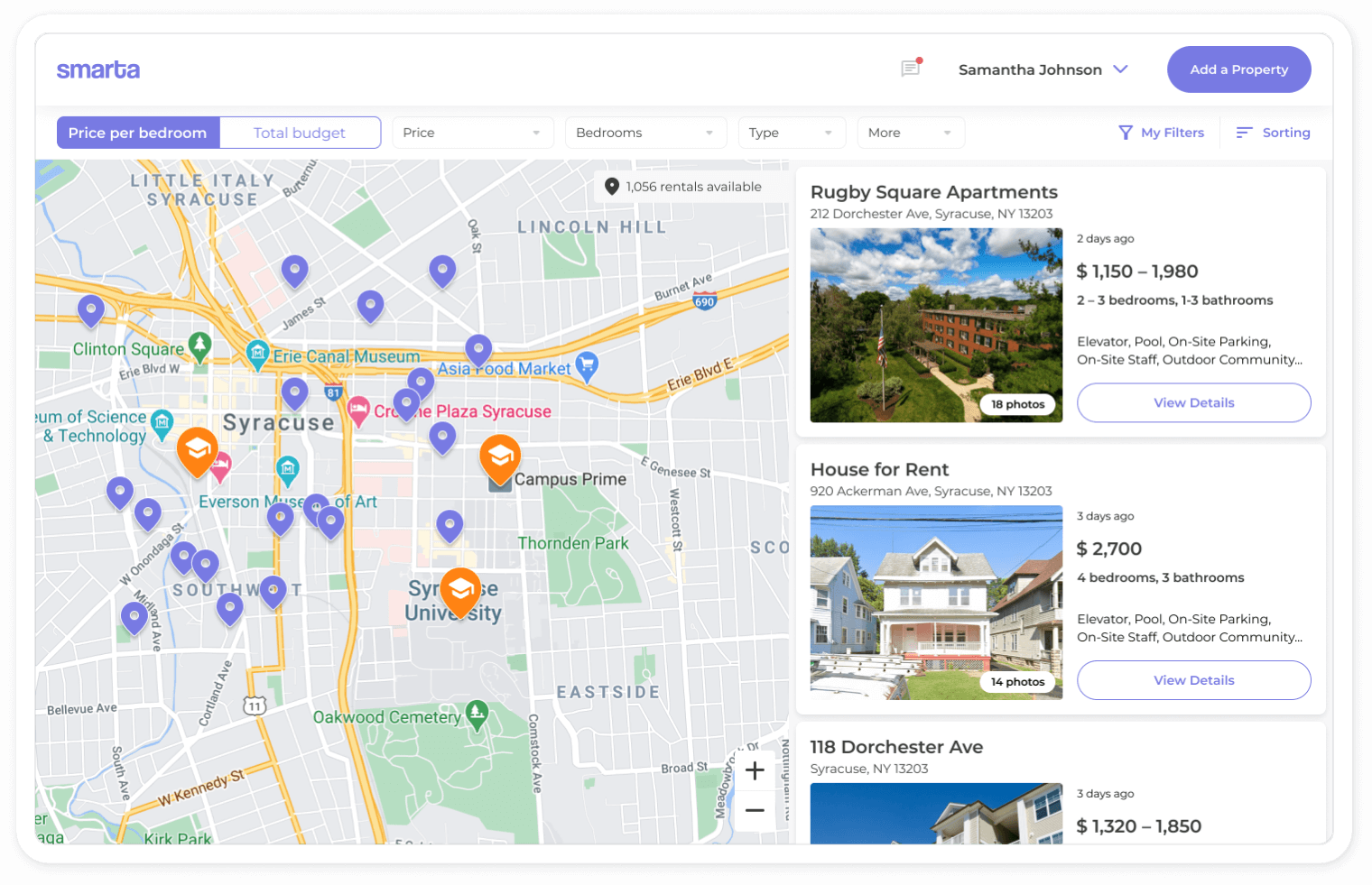
See an implementation of this feature in ORIL’s case study for Smarta
5. Payment processing
If you decide to maximize the value of your real estate site and diversify the income sources, you will need a payment provider to integrate on your platform. There are numerous opportunities for making money. You can introduce paid options on premium features and services for the end-users or range accessibility and fees by creating various subscription plans. See a list of the most popular payment processing services in the Integration paragraph below.
Read more about recommended monetization strategies in our article “What monetization strategy should I choose for my app.”
6. Documentation and e-signature services
Customers expect each step of the real estate process to be easy and fast. Digital technologies and electronic signature platforms made it possible by bringing unparalleled speed and convenience to all participants of the process. Implementing an electronic signature solution like HelloSign or DocuSign guarantees improved ways to produce, manage, and send legal documentation involved in a home purchase. It will give you the freedom to close deals faster, create and eSign documents from any device quickly, safely, and with maximum legal security.
7. Admin dashboard
An industry as complex and multifaceted as real estate requires a solution that can handle it all. Admin panel allows managing every action, controlling all the entities, and tracking analytics from a single interface. A comprehensive well-arranged dashboard should provide:
- User management
- Streamlined property listings
- Report generation
- Application analytics
- Ticketing and user support
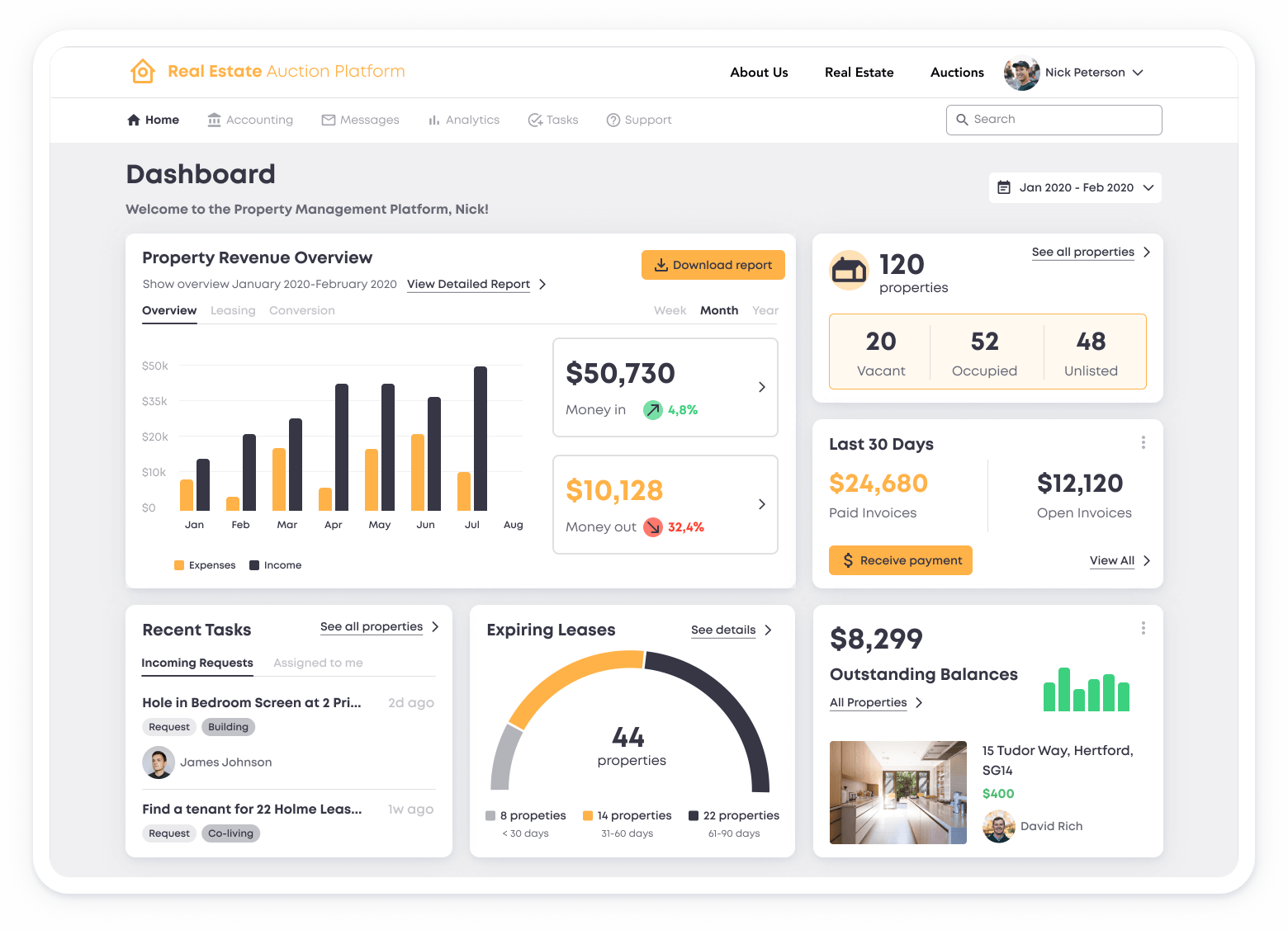
8. Platform management and analytics
Real estate agencies must have real-time insight into their data and make informed decisions to sustain their growth. With advanced analytics tools, you will be able to leverage critical data from property management and finance systems, sales, tenant, and lease information to enhance the bottom line.
Design: Best practices for real estate UI/UX web design
Since buyers visit multiple real estate listing websites to search for a property, they expect a great user experience, and you need to be ahead of the game. Users have become more demanding than ever. So it’s vital that your listing page combines design and usability to maximum effect and follows the best practices of the real estate listing business.
Before diving into some of our tips, let us underline a few principles of effective web design you should pursue no matter what: responsiveness, client-centered approach, mobile-friendliness.
1. User-focused web design
We believe that user-centered platform design should come first and foremost in real estate web design. The idea behind this approach is to create a platform based on an explicit understanding of end-users.
This is a method of bringing potential users into the process to create a specific user experience. In other words, crafting a design aimed at the emotional satisfaction of a user. The investigative methods like research, surveys, user interviews will help you achieve a client-oriented result.
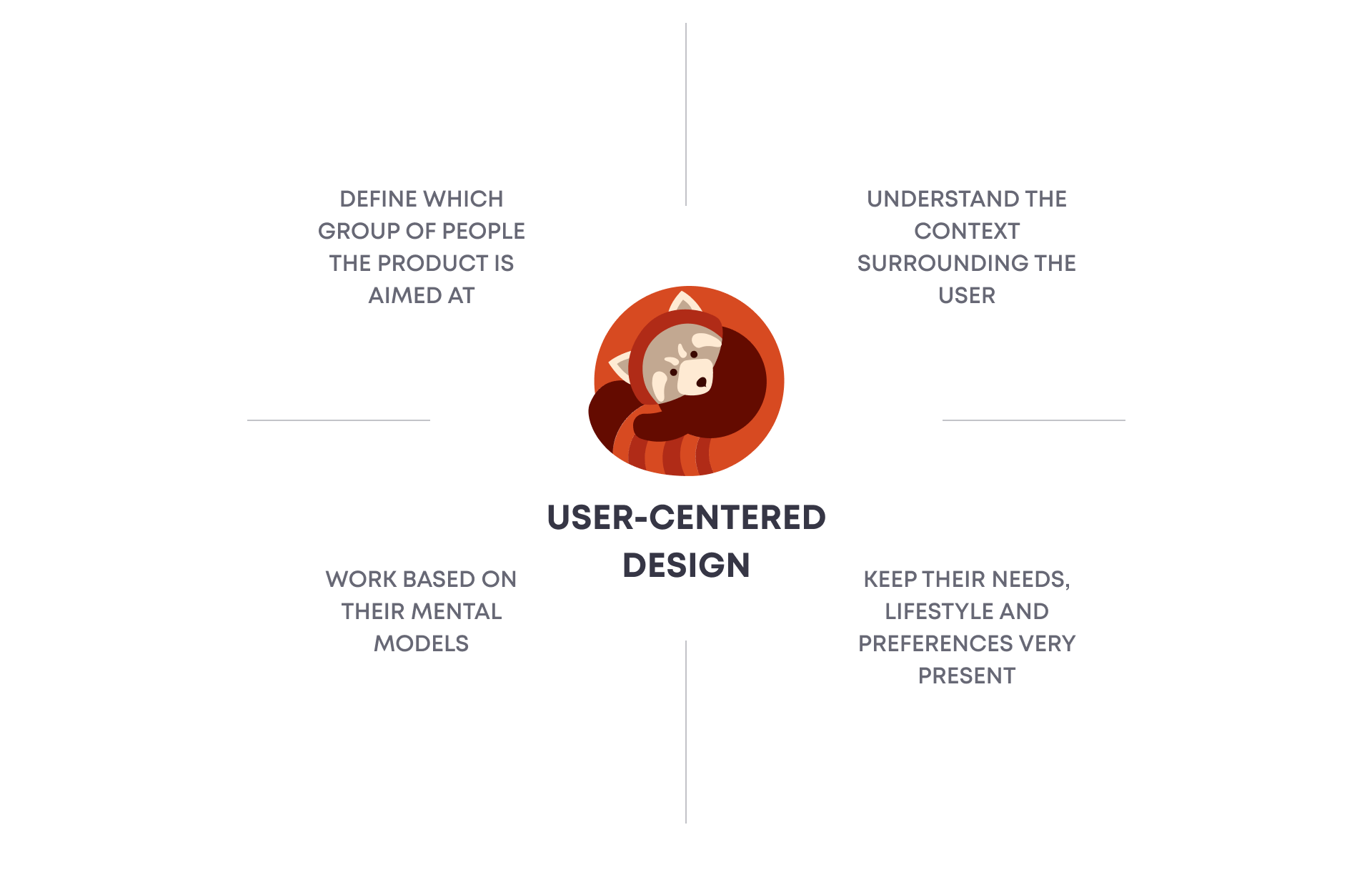
We selected a few resources where you can gain more insights on how to make and implement attractive UI with impactful UX, taking into account your users’ needs and their behavior:
Mouseflow is another handy tool the ORIL team prefers to use for discovering insights on customer interactions with a platform. Session recordings and heat maps received via this analytics platform allows iterating and polishing UI/UX designs.
2. Pleasing UI
UI design is the main instrument for your property listing platform to draw users’ attention, promote your services, and achieve success. 75% of consumers base their opinion of a website on design alone.
An expert designer tuned in to the latest UI trends knows which elements from their large design kit to use to create the fantastic interface and provide the user with an impeccable experience. Using motion graphics and illustrations inspires visitors to spend more time on the website and pay more attention to the service you offer.
Proven by our UI/UX designers, Material Design and Ant Design systems can help you create an eye-catching real estate web design that builds the initial connection with customers and prolongs their stay.
3. Balance between usability and aesthetics
A flashy site overloaded with features, trendy animation, and details is likely to fail usability testing. Fantastic design magnetizes visitors without contributing to the goal of a website.
In the hunt for visual elements, don’t forget that people come to the property platform to seek information. If potential buyers face difficulties finding the property they’re looking for, they will opt for a more user-friendly website.
Notice, 88% of customers admitted that they wouldn’t return to a site after a bad experience.
Rather than thinking of how your website can showcase your expertise, consider how users will interact with your platform. Give online visitors a pleasurable experience, and they will return.
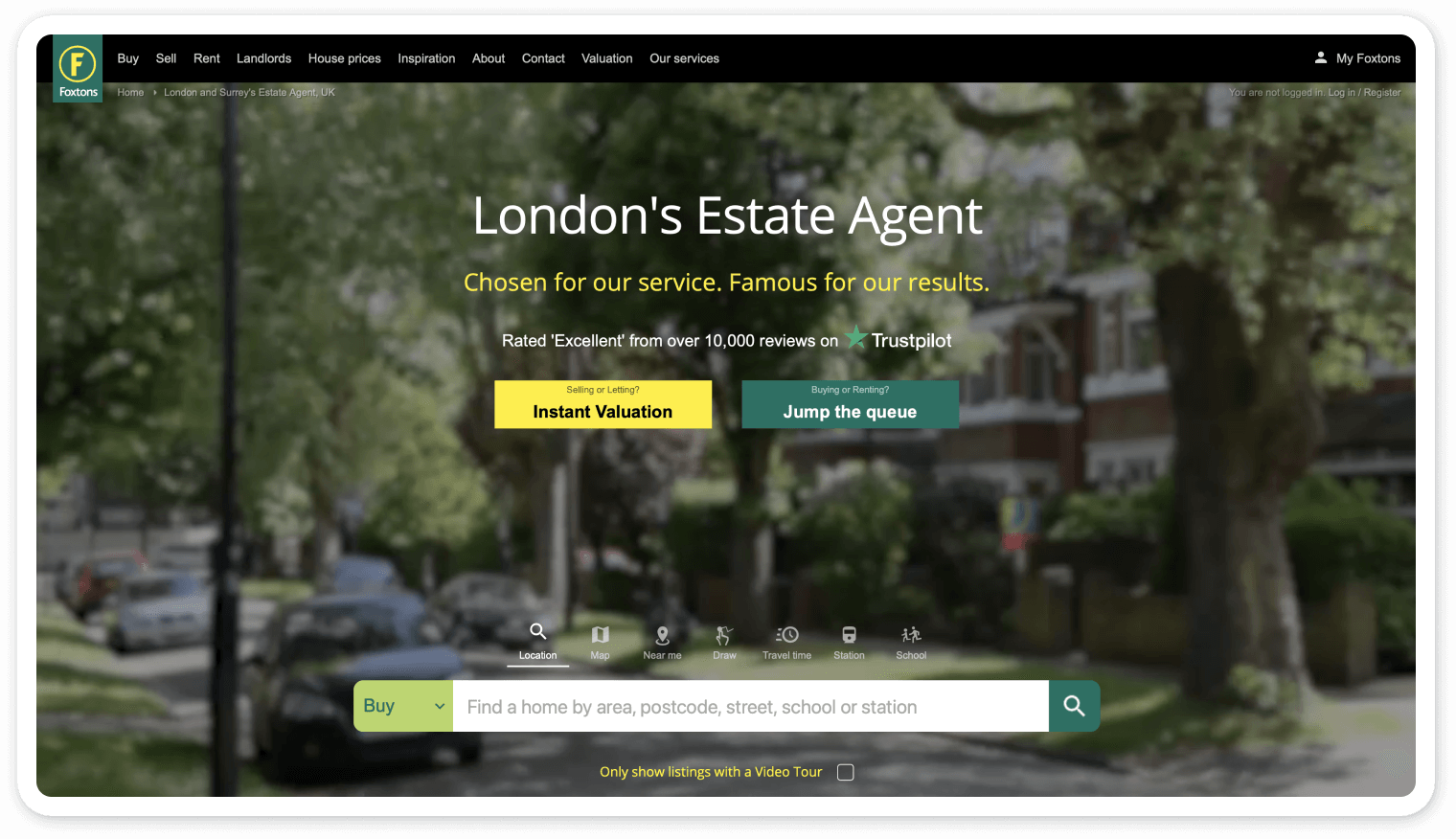
Given that, we, as a real estate web design and development company, advise you to couple your creativity with functionality. Then turn this combo into a top-notch design that meets the requirements, including:
- Appealing UI – plays a visual and emotional role in attracting customers.
- Information structure – clutter-free and relevant data should be arranged in an intuitive informational structure.
- Accessibility – your website should provide equal access and equal opportunity to people with diverse abilities.
- User-friendliness – site browsing doesn’t require significant mental efforts.
- Responsiveness – more than half of your prospects will likely be on their smartphone when they come across your property finding service. Make sure your website is responsive to any device and operating system.
4. Intuitive and simple navigation
Typically, a property platform contains so much information that it may get difficult to navigate. Yet, a good UI implies that people don’t have to waste their time figuring out how to find their way around your website.
Your real estate marketplace should have a well-planned navigation structure with an intuitive sitemap and user-friendly menus. Keep your website clean and uncluttered and position site elements such as navigation buttons where users anticipate them.
You can apply an unofficial 3-click rule to test whether the navigation is easy to use. Three is the optimal number of clicks that a user needs to find the necessary content.
UI/UX design is complicated and requires a lot of work and expertise. As specialists in this field, we would be pleased to help you create a superb design. You can find out more about Product Design on our dedicated PD service webpage or contact us directly for more information.
Technologies: Modern technologies that empower online property listing sites
Selecting the right tech stack is crucial for implementing the features and functionalities most effectively. It directly depends on your project size, complexity, and required functions.
Keeping in mind the essential real estate website requirements, we have created a list of the robust technologies and integrations that will ensure your platform’s scalability and high performance.
Technologies
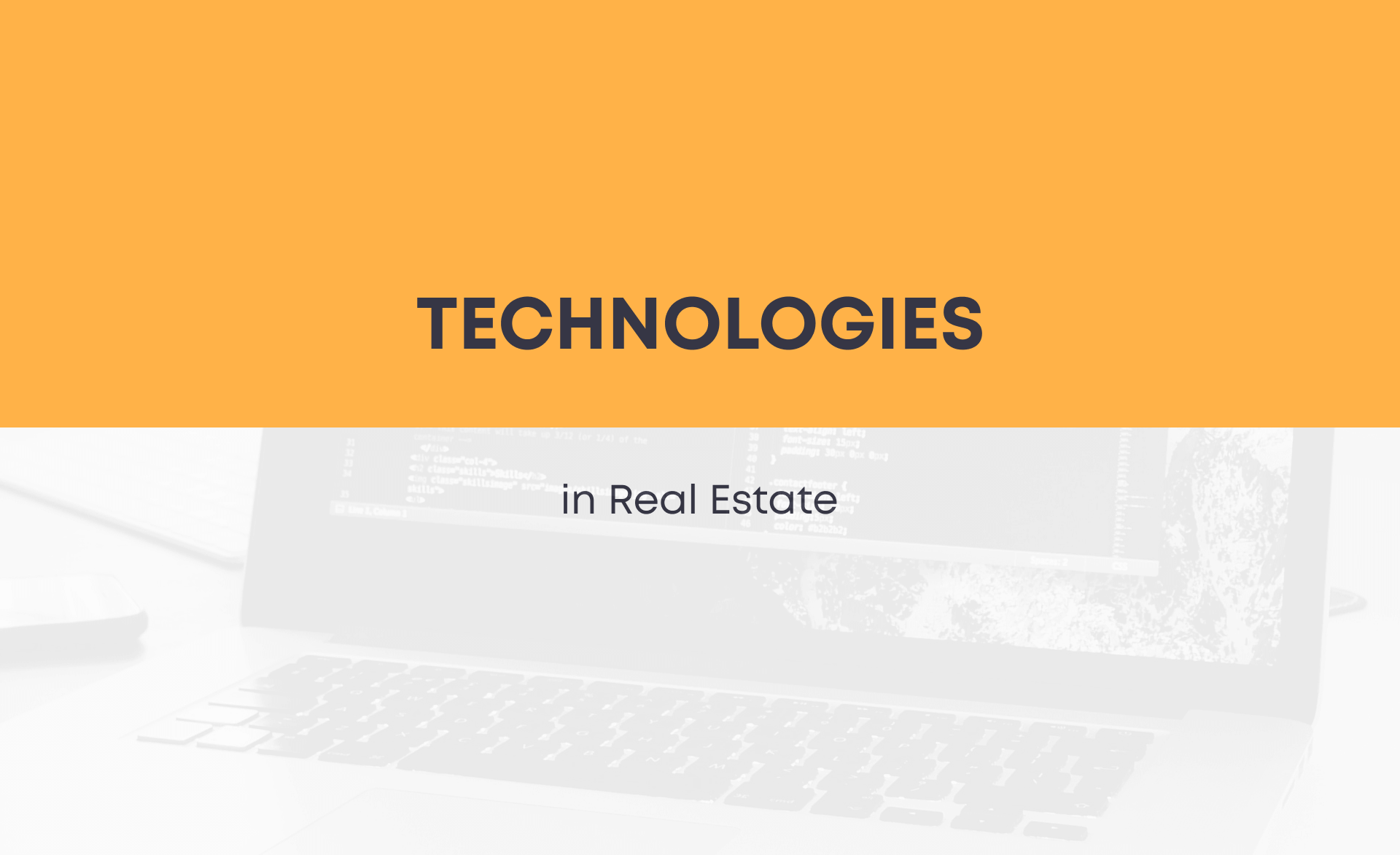
- Back-end: NodeJS | Java | Python – are some of the top technologies our team uses for building the robust back-end for realtor listing sites.
- Front-end: Angular | React – free web frameworks that allow building interactive, dynamic user interfaces quickly and efficiently.
Mobile: ReactNative | Flutter | Ionic – is designed to simplify the creation of hybrid applications. We use these frameworks to build performant, high-quality multiplatform apps that flawlessly run on various devices and operating systems. - Database: MySQL; MongoDB; Amazon S3 – depending on requirements and project size, we choose either MySQL or MongoDB to create databases for storing and manipulating massive amounts of data securely and smoothly with optimum speed. The scalability of Amazon S3 is the right solution for property listing portals containing a considerable amount of high-quality photos and videos.
- Infrastructure: Amazon | Google Cloud | Azure – offer robust hosting servers that address image system scalability, performance, security, and disaster recovery challenges. Cloud servers are also cost-efficient due to their ability to scale up or down in response to load. The real estate industry is making its way into the cloud, and ORIL helps businesses move their system to cloud-based infrastructure.
Integrations
Here are essential APIs and third-party integrations that might be useful for your product and help you deliver rich functionality and contribute to a better user experience.
- Work with documents: DocuSign | HelloSign | AdobeSign – with these e-signature services, you can securely work and manage documents, send, track, and sign all your contracts online.
- Payment processing: Stripe; Authorize.net; PayPal; ApplePay – we recommend choosing from these popular payment processing systems that provide quick and secure online transactions. Determine the most used payment gateways in the region your platform focuses on.
- Maps: Google Places API; Google Maps API – easy-to-use tools familiar for many users. They will help you display the property location and details about the local area and neighborhoods.
- Notifications: Twilio – a cloud communication platform that can process voice and video calls, text messages, build chats and call centers. This service instantly connects your prospects with professional agents improving conversion rates.
- SendGrid – an email marketing service that will help you send bulk emails with extremely high email deliverability rates. Integration with SendGrid API enables sending high-volume email marketing campaigns with ease.
- Cloudinary – the platform comes with lots of user-friendly editing tools simplifying the management of your media. It’s a valuable cloud-based service for seamless optimization of images and videos to ensure high website performance.
- Segment, Hubspot – are tools that help you to better understand and optimize your customer preferences via data analytics. They collect events and customer interactions with a platform and deliver data toolkits for your marketing, product, and engineering teams.
Building a custom real estate web app powered by high tech is challenging and requires diverse expertise. So a skillful team of specialists is the right place to request and get expert opinions, risk evaluation, and other decision-making information.
Bonus: How to reach and engage your audience
Now, you may think that having a modern, professional home listing site with a perfect look and feel is enough to achieve your goals. But it’s only half the battle. The second half is to get your listings seen by your prospective customers. Here are some suggestions on how to spread awareness of your real estate site by adding simple features and introducing user engagement strategies.
Unique features
If the recommended basic features are a backbone of a good property web website, advanced and value-added features give extra options for the user experience improvement, making the platform exceptional.
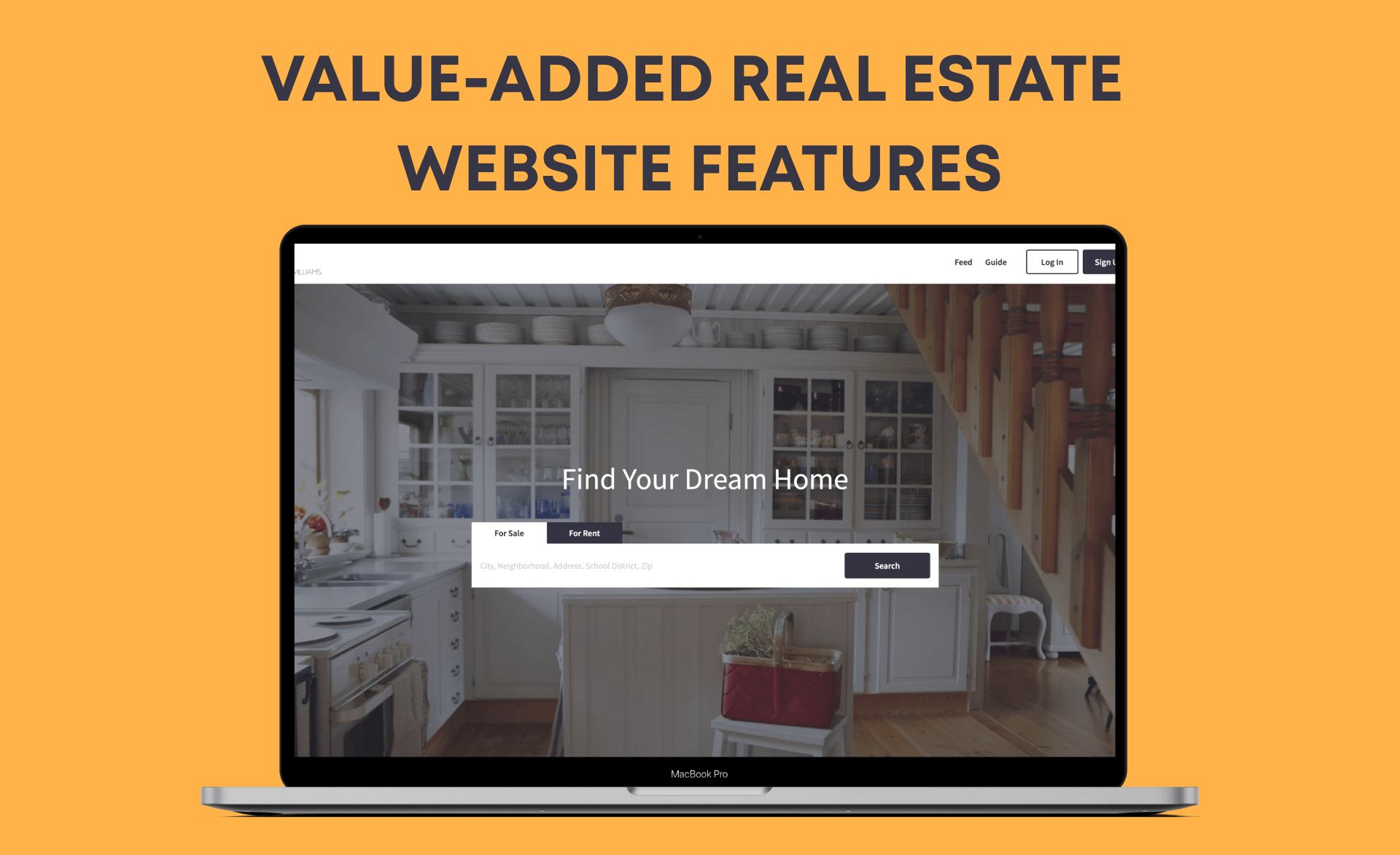
- Price check helps buyers to identify the actual cost they would like to pay for a property.
- 360-degree videos would be an excellent addition to professional photos of houses. 69% of people prefer to learn about a product via a short video. Take a chance to provide users with comprehensive information about the exterior and interior modeling, thus saving time and attracting more customers.
- Local information. Tenants and buyers tend to learn as much property details and information about the neighborhoods as possible. They will appreciate it if you provide them with detailed search results including, public transportation, crime rate, demographics, and more.
- Favorites allow your users to save suitable properties and make a decision easier.
- Calendar helps check agents’ availability and book meetings or property viewing in a web application.
- In-app chat connects buyers and sellers 24/7 providing an opportunity to specify property information directly.
- Analytics tools for agents and sellers that reflect user interactions with your site, pages, listings, and content, give you valuable insights for further improvements and business growth.
The above features incorporated into your real estate listing site will draw customers’ attention with a seamless and effective real estate process while catering to agents with advanced functionality.
Real estate web application marketing hacks

To help your new property website break through the noise and position yourself as a professional in an overcrowded market, try the following marketing hacks.
- Build social media presence. Social media is a chief tool for letting your audience learn more about you and your market, build brand awareness, and craft lasting relationships with your customers. Integrating social media with your home listing website maximizes your reach on both platforms.
Furthermore, social sharing buttons allow users to share listings on social platforms to attract potential buyers or receive feedback. Be sure to make any links trackable so that you can understand which social media services are driving the most shares and visits to your property listings. - Introduce referral programs. If you want to optimize your business’s sales cycle and generate qualified prospects, a referral program can be the solution. It allows improving your ROI while cutting your actual marketing expenses. To make yours prosperous, you need to put time and effort into developing, maintaining, and managing programs and relationships with agents. The incentive you offer to current customers to refer you to prospects will pay you off.
- Start a blog. A blog is a perfect opportunity to engage with your potential buyers and generate organic traffic from search engines. Sharing home buying tips, real estate news, home loan types, and other valuable information builds your authority and relationships with prospects. What’s more, a blog levels up your SEO and makes you visible to the target audience.
- Launch email marketing campaigns. Email marketing provides the opportunity to increase your client base, nurture relationships, and dramatically grow sales. It may be most effective for you to segment your contact list and send out personalized content. Send your subscribers the information they’re looking for: new houses on the market and upcoming open houses info for first-time home buyers, special offers, or general homeowner tips for those who have bought a home with you.
- Partner with local businesses. Developing partnerships with local businesses is beneficial for both parties. Partnering with home improvement companies, mortgage brokers, or movers, you can provide referrals to one another. Moreover, you can bundle your services together so consumers can find all the assistance they need.
- Use Google My Business. It’s a free yet powerful local marketing tool that allows business owners to manage how their business is displayed on Google Maps. Creating your profile with this service is a critical step in any local marketing and SEO strategy. It facilitates finding information about your business for customers and allows them to review it too.

- Create social media ads and PPC. Social media ads and PPC or Pay Per Click is one of the fastest ways to drive prospects to your site to market any home you might be offering. However, it costs money. Essentially, you’re paying for your website’s visitors. Hence, make sure your keywords and demographic targeting are correctly adjusted to reach your prospects.
- Add client testimonials. Social proof in the form of testimonials is one of the most powerful ways to inspire trust and force people to turn to you in a quest for a new home. Ask some of your satisfied customers to write a testimonial that highlights your unique strengths. Dedicate a section of your homepage to a few clients’ reviews and convert random visitors into paying customers.
You no longer need to hope that a potential buyer will find you by accident. Take these dedicated steps to reach your audience and get your real estate listings to stand out.
Examples of successful Proptech companies
We’ve gathered five examples of real estate platforms that generate massive traffic volumes and considered the best sites to find, buy, sell, and rent properties.
Realtor.com
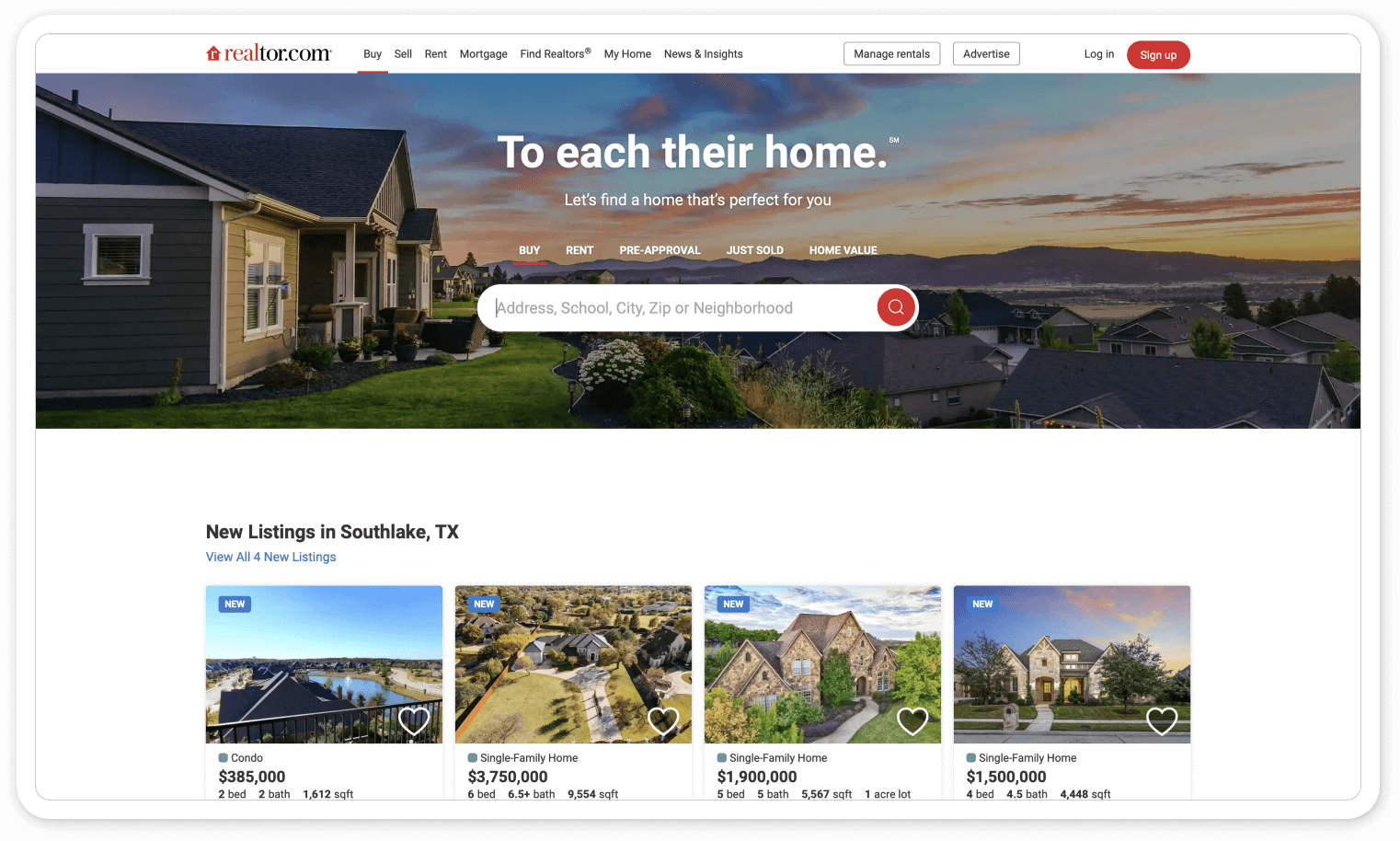
Realtor.com is among the major US real estate marketplaces, with around 18 million unique visits per month. Linked to over half of a thousand regional MLS, which are regularly updated, the platform provides the most accurate real estate listings data.
The company gets revenue from offering the best listing presentation software and first-rate tools for agents like lead generation system Connections Plus, advertising program Market Reach, real-time Market Insight reports, etc.
Having brand recognition, good traffic volume, and great exposure for listings agents, Realtor.com impresses clients with listings and performance reports.
Foreclosure
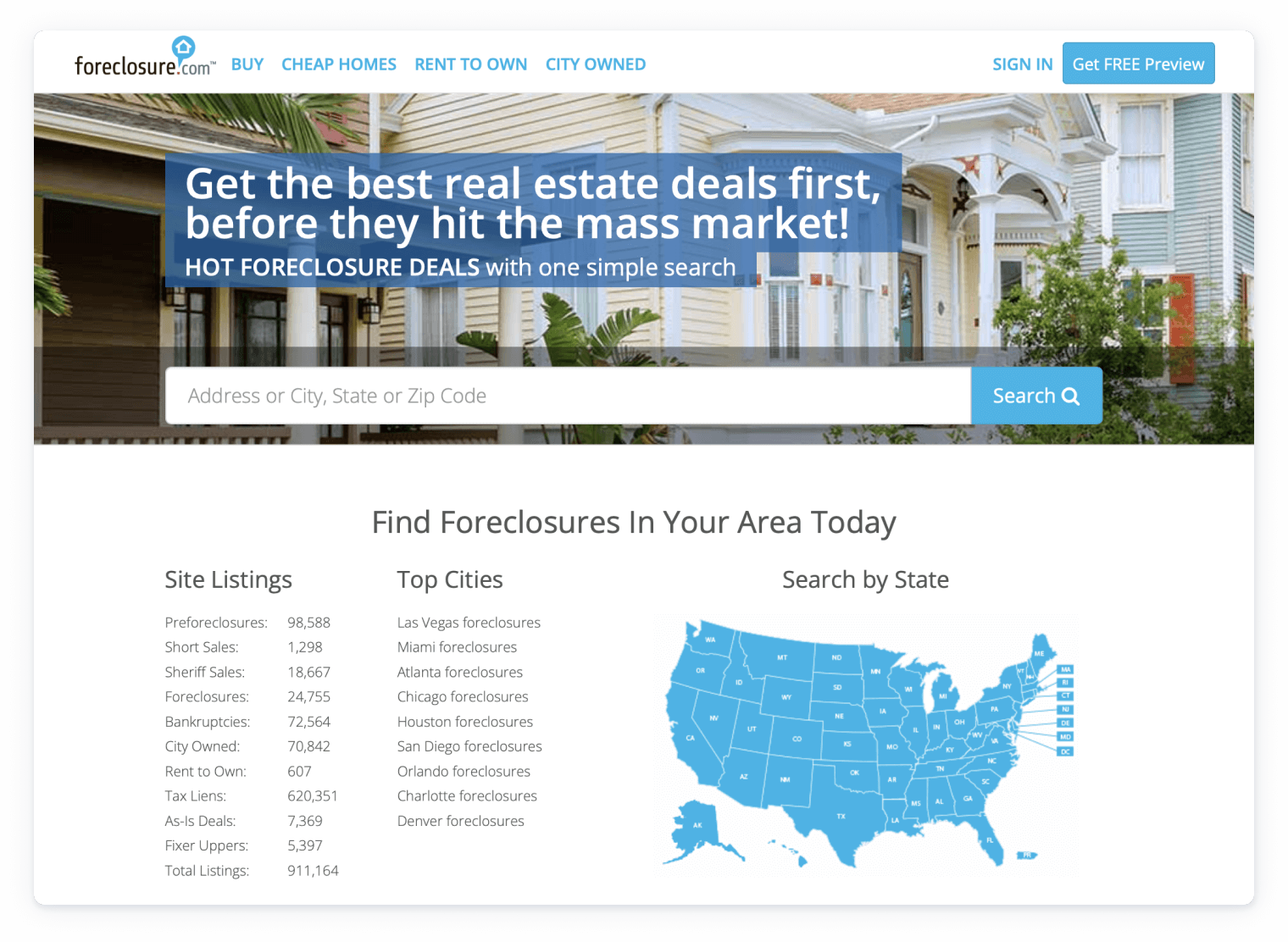
This website is an excellent resource for those who are searching for the best-foreclosed properties to invest in. Foreclosure is America’s biggest provider of distressed properties such as bankruptcy listings, preforeclosures, actions, and foreclosures. The platform offers over 700 thousand listings with photos and detailed information.
In-depth search features, filtering, and educational content on the process of purchasing a foreclosure make the platform a one-stop-shop service for these specific types of property listings.
Trulia
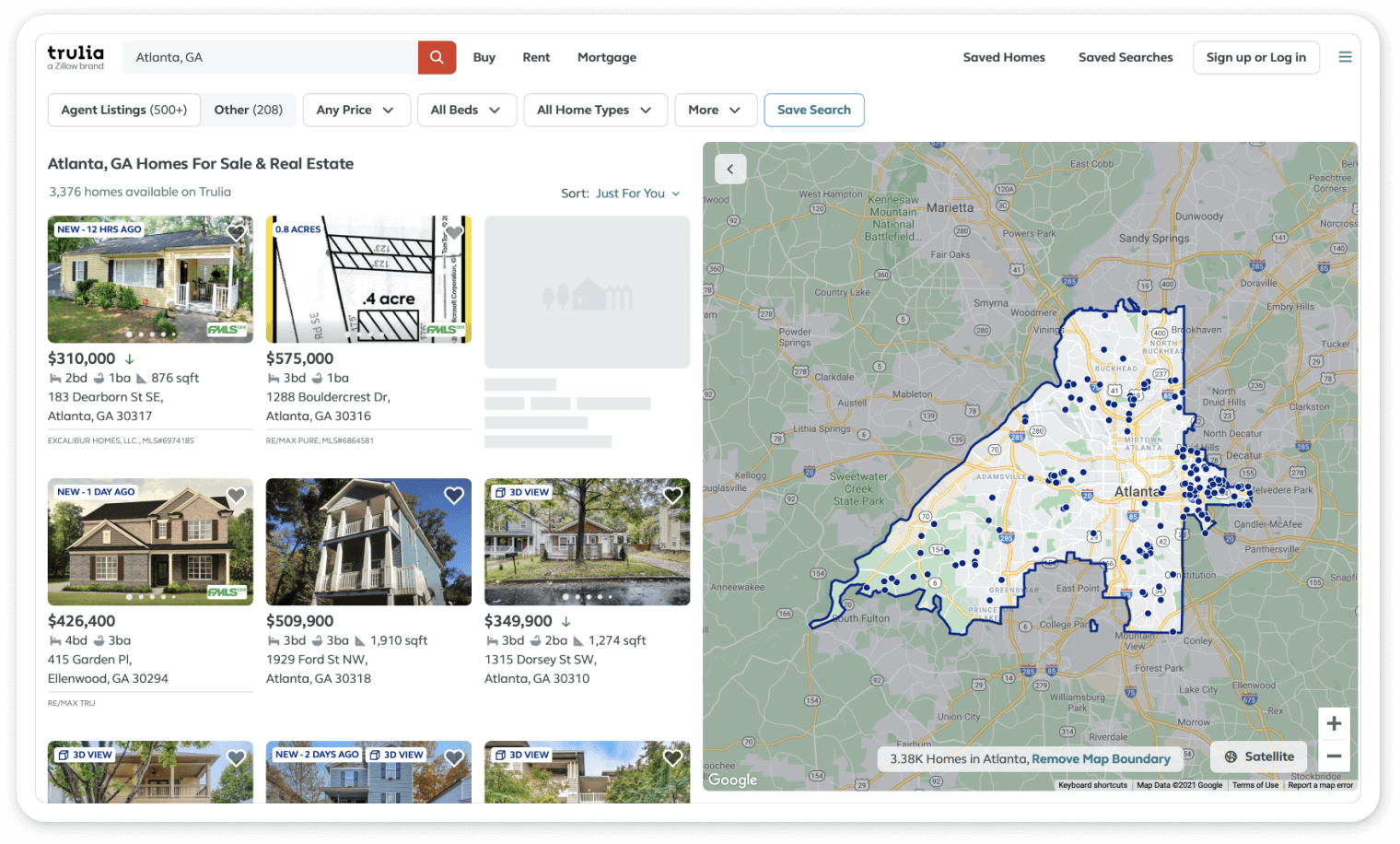
Trulia is the second most popular residential real estate listing platform by traffic volume after Zillow. Trulia stands out due to its focus on a surrounding area’s lifestyle factors. The platform’s map displays a wealth of neighborhood data, including crime statistics, the proximity of stores and cafes, local schools, public transportation options, and much other helpful information.
One more area where Trulia shines is buying tools like an affordability calculator. Unlike most mortgage calculators, Trulia includes other related housing costs such as insurance, property taxes, fees.
Zillow
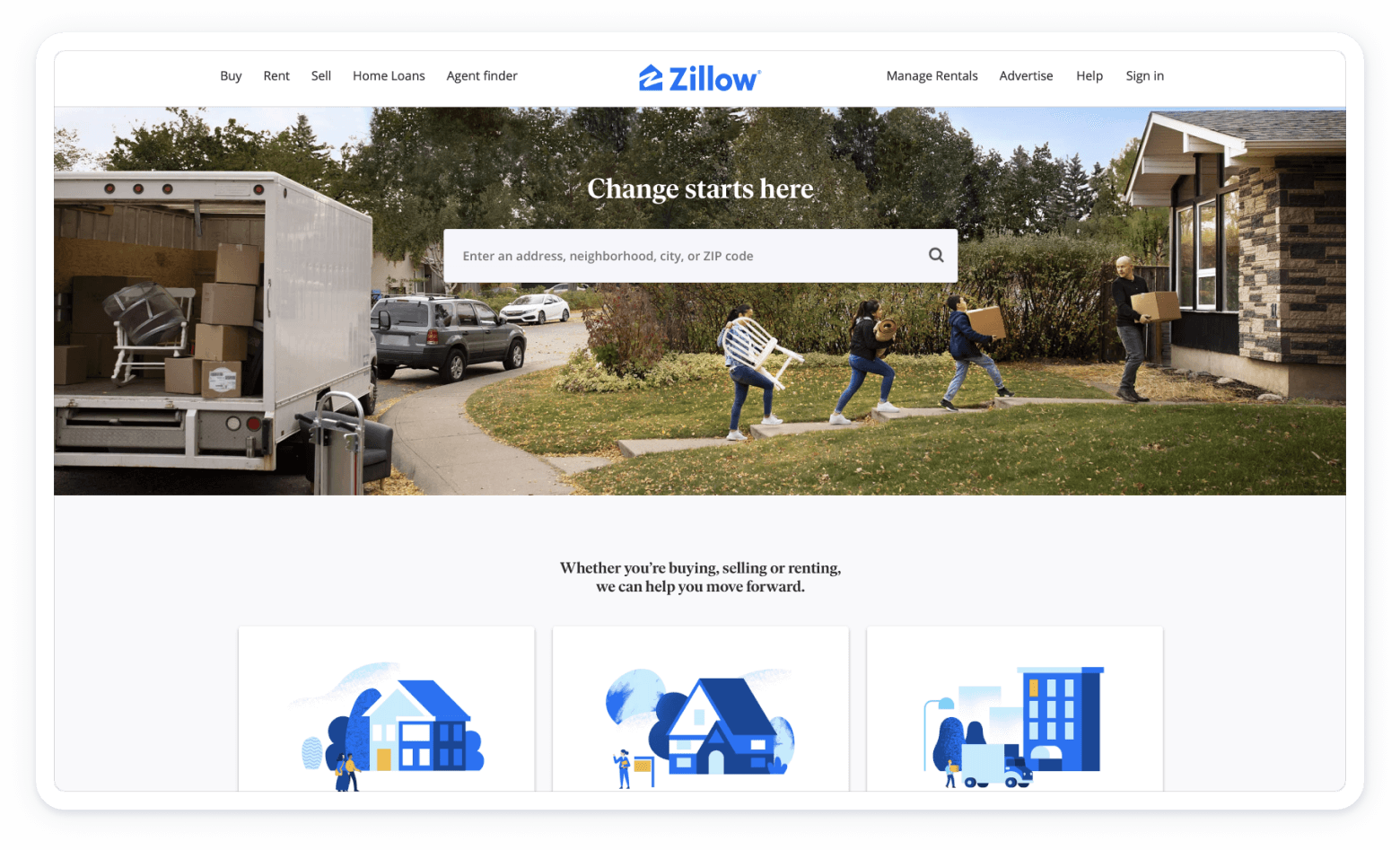
Zillow is the most visited real estate marketplace attracting over 30 million visitors a month. The giant mainly got revenue from charging professional agents an advertising fee while providing free services for homebuyers.
Zillow’s main strengths are its enormous home database of over 100 million houses, an array of free tools for customers, powerful technology support, and great advertising opportunities for property managers, mortgage lenders, agents, and other industry professionals.
Hassle-free experience due to intelligent listing search and value-added functionality for both buyers and sellers results from millions of investments in technology and a large dedicated team working 24/7.
Apartments.com
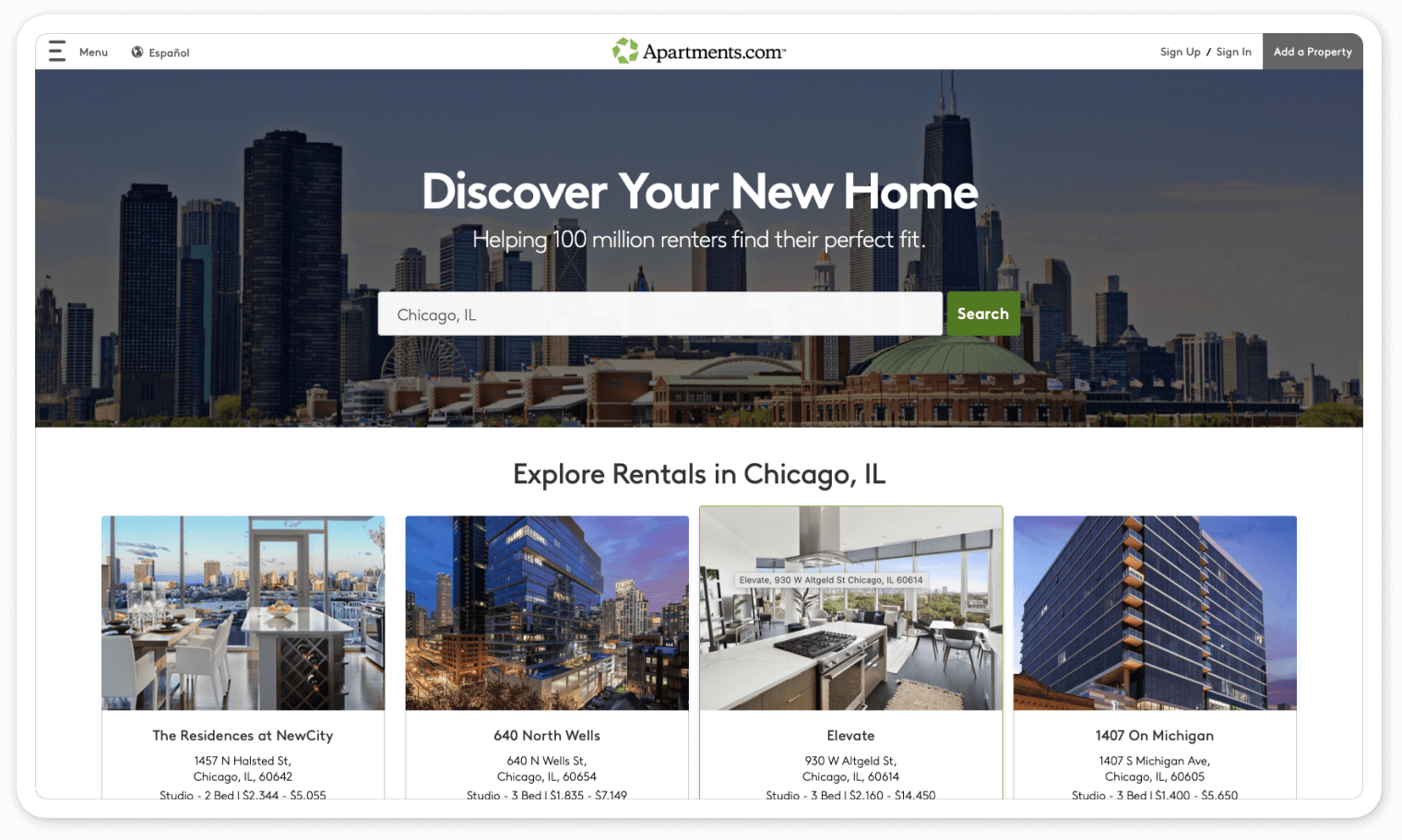
The platform is one of the most comprehensive search engines for rentals. It offers a nicely designed map and a broad range of filters that make it easy for applicants to search for a property. The website lets you view HD videos and virtual 3D tours of listings, access reviews and ratings for a fee.
Apartments.com is designed to advertise units in large apartment buildings and is best suited for professional property managers. Most of their advanced features and property management software products are subscription-based.
ORIL experience
ORIL is well-versed in the complexities and challenges that come with real estate web application development. Our team has extensive experience building property listing portals and property management software based on competitor research and sophisticated industry-specific functionality.
To find out what we’re capable of, view some of our real estate projects.
Real estate listing and bidding platform
The US-based real estate platform simplifies the selling process by allowing buyers, sellers, and agents to collaborate.
We have digitized the existing client’s offline business and implemented a PropTech process that provides all-inclusive, secure, and transparent means for homebuyers to interact directly with sellers.
Buyers can register and make bidding offers for a property with or without the assistance of their agents. Sellers receive an immediate notification of buyer’s offers and have the opportunity to sell their homes at the highest price faster and easier.
Smarta
We designed a rental platform that connects college student renters and property managers, providing a smooth and easy leasing process of housing properties.
The outcome of our collaborations with the client is a responsive, easy-to-use web application with lots of features:
- Robust search engine with filtering algorithms
- Online application submission
- Live chat
- Property management system
- Online payments
- Intuitive navigation
- Pleasant UI/UX designs
- E-signing service
- Interactive map

Wrapping up
After the real estate industry entered the digital space and discovered the endless possibilities of online web presence, purchasing and selling homes became simple than ever.
Whether it’s a global marketplace or a simple website for your local business, invest enough time and money to succeed.
Building a property listing platform doesn’t happen overnight. You don’t need to be a tech guru. But strategic thinking, careful research, and collaboration with a reliable real estate web development vendor will give you a solid chance to create and scale your project.
